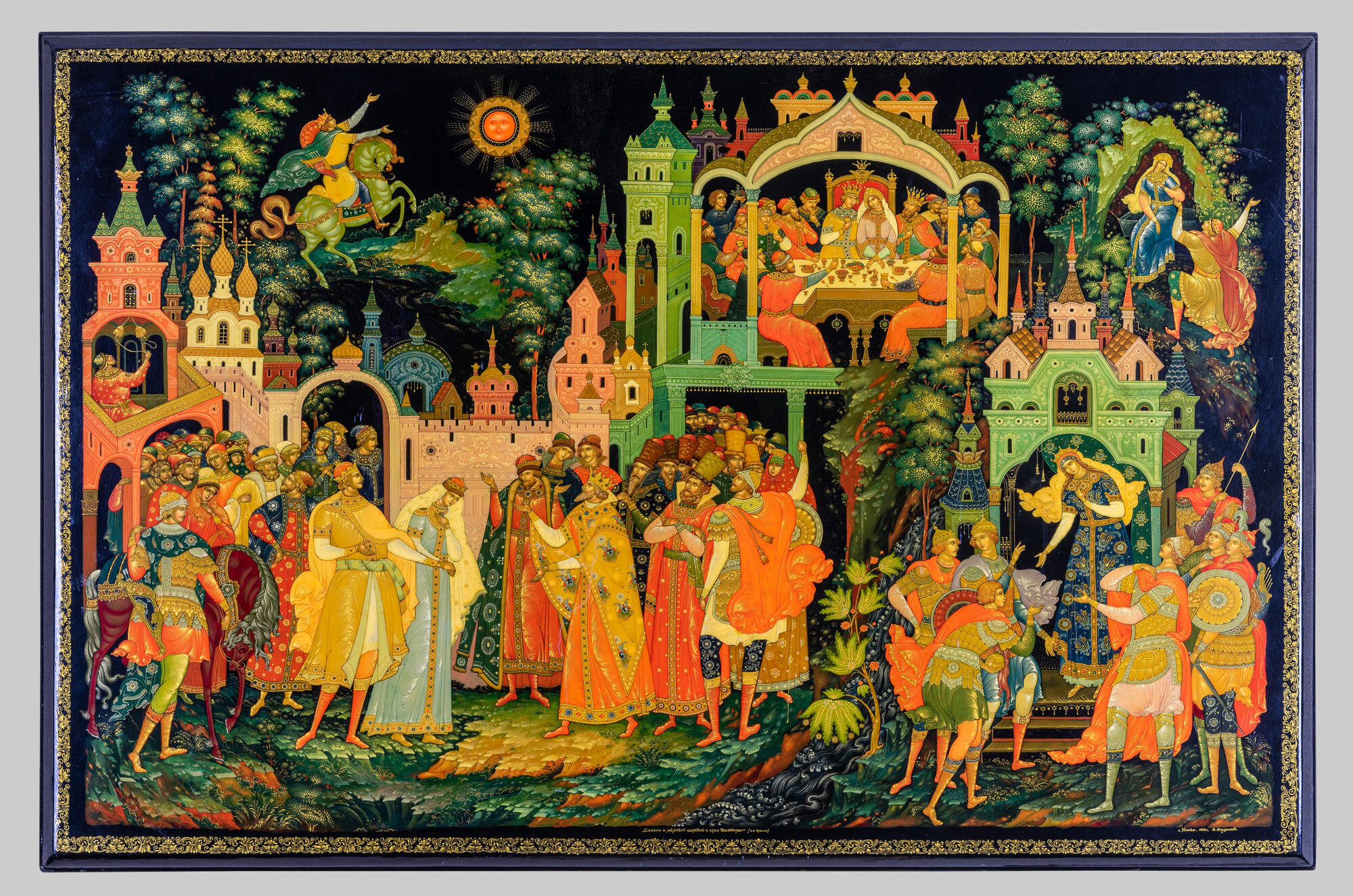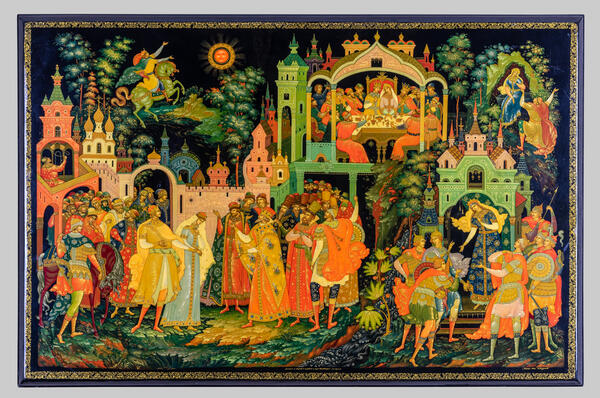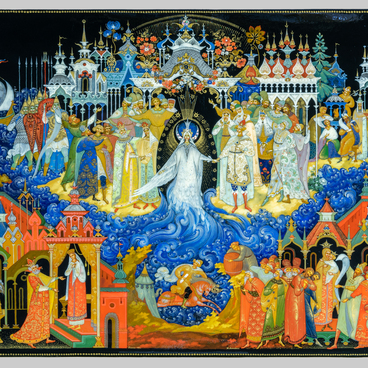Aleksei Kochupalov painted the panel ‘The Tale of the Dead Princess and the Seven Knights’ in 1992. This is one of the last major artworks which he made in the Old Palekh tradition.
Alexei Kochupalov began his artistic career around the time when the realistic trends took over in the local art scene. Many artists strived for fidelity in their artwork, which wasn’t Aleksei Kochupalov’s idea of the essence of the Palekh art at all. He stubbornly stuck to the style of old masters, their composition arrangement techniques, their color palettes, and their ornament patterns. ‘The Tale of the Dead Princess and the Seven Knights’ is a very nice specimen of that style.
The artist managed to unite a considerable number of scenes into a single composition. The final scene of the fairytale is in the center: Prince Yelisei has found the princess, she came back to life after a kiss, and they returned back home. The artist depicted the celebration dedicated to the triumph of kindness and justice. Atop the depiction of the crowded event is the feast scene — it’s one of the iconic images in the art of Palekh.
Select episodes from the fairytale are also included in this common space. There are two scenes on a smaller scale at the top. On the left, prince Yelisei asks the Sun for help. In the fairytale, he speaks these words:
Now to the bright Sun in zeal did the bold young Prince appeal: Sun, dear Sun! The whole year coursing
Through the sky, in springtime thawing
From the chill earth winter snow!
You observe us all below.
Surely you’ll not grudge an answer?
Tell me, did you ever chance to
See the Princess I revere? ’
In the top right corner the artist shows Yelisei who already found his bride, now holding her hand.
Aleksei Kochupalov’s artworks are considered to be very finely painted. His lines are always expressive, precise, and energetic. In this artwork, the power of the imagery is reinforced with a vibrant color table. Bright colors make each other pop, and ever-present reds and greens highlight the holiday spirit of the plot. Traditional golden gaps give volume to the conventional shapes.
The artist often based his artworks on Pushkin’s poetry. The museum collection also includes his milestone artworks: “The Mermaid” and “Autumn.”
Alexei Kochupalov began his artistic career around the time when the realistic trends took over in the local art scene. Many artists strived for fidelity in their artwork, which wasn’t Aleksei Kochupalov’s idea of the essence of the Palekh art at all. He stubbornly stuck to the style of old masters, their composition arrangement techniques, their color palettes, and their ornament patterns. ‘The Tale of the Dead Princess and the Seven Knights’ is a very nice specimen of that style.
The artist managed to unite a considerable number of scenes into a single composition. The final scene of the fairytale is in the center: Prince Yelisei has found the princess, she came back to life after a kiss, and they returned back home. The artist depicted the celebration dedicated to the triumph of kindness and justice. Atop the depiction of the crowded event is the feast scene — it’s one of the iconic images in the art of Palekh.
Select episodes from the fairytale are also included in this common space. There are two scenes on a smaller scale at the top. On the left, prince Yelisei asks the Sun for help. In the fairytale, he speaks these words:
Now to the bright Sun in zeal did the bold young Prince appeal: Sun, dear Sun! The whole year coursing
Through the sky, in springtime thawing
From the chill earth winter snow!
You observe us all below.
Surely you’ll not grudge an answer?
Tell me, did you ever chance to
See the Princess I revere? ’
In the top right corner the artist shows Yelisei who already found his bride, now holding her hand.
Aleksei Kochupalov’s artworks are considered to be very finely painted. His lines are always expressive, precise, and energetic. In this artwork, the power of the imagery is reinforced with a vibrant color table. Bright colors make each other pop, and ever-present reds and greens highlight the holiday spirit of the plot. Traditional golden gaps give volume to the conventional shapes.
The artist often based his artworks on Pushkin’s poetry. The museum collection also includes his milestone artworks: “The Mermaid” and “Autumn.”



